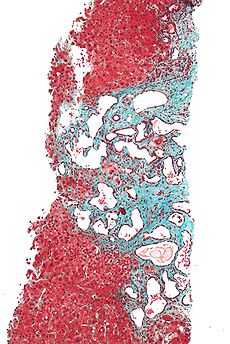Bile duct hamartoma

A bile duct hamartoma or biliary hamartoma, is a benign tumour-like malformation of the liver.
They are classically associated with polycystic liver disease, as may be seen in the context of polycystic kidney disease, and represent a malformation of the liver plate.[1]
Eponym
The eponymous terms (von Meyenburg complex, Meyenburg complex) are named for Hanns von Meyenburg.[2][3]
Diagnosis
At CT scans, bile duct hamartomas appear as small, well-defined hypo- or isoattenuating masses with little or no enhancement after contrast administration.[4] At MRI, they appear hypointense on T1-weighted images, iso- or slightly hyperintense on T2-weighted images, and hypointense after administration of gadolinium based contrast-agent.[4] On imaging, multiple hamartomas may look similar to metastases or microabscesses.
See also
Additional images
-

Micrograph of a bile duct hamartoma. Trichrome stain.
-

Low magnification micrograph of a bile duct hamartoma. Trichrome stain.
-

Gross pathologic appearance of a large bile duct hamartoma.
References
- ↑ Desmet, VJ (Jan 1998). "Ludwig symposium on biliary disorders--part I. Pathogenesis of ductal plate abnormalities.". Mayo Clin Proc 73 (1): 80–9. doi:10.4065/73.1.80. PMID 9443684.
- ↑ synd/1693 at Who Named It?
- ↑ H. von Meyenburg. Über die Zyztenleber. Beiträge zur pathologischen Anatomie und zur allgemeinen Pathologie, Jena, 1918, 64: 477-532.
- ↑ 4.0 4.1 Horton, KM; Bluemke, DA; Hruban, RH; Soyer, P; Fishman, EK (Mar–Apr 1999). "CT and MR imaging of benign hepatic and biliary tumors.". Radiographics : a review publication of the Radiological Society of North America, Inc 19 (2): 431–51. doi:10.1148/radiographics.19.2.g99mr04431. PMID 10194789.
External links
- Bile duct hamartoma - pathconsultddx.com.
| ||||||||||||||||||||||||||||||